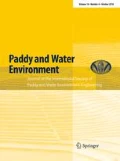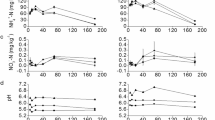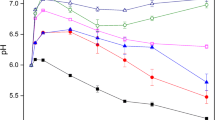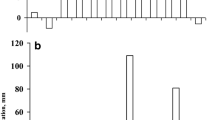Abstract
The process of greenhouse gas (GHG) emission processes is substantially affected by soil factors. Here, an intensive experiment was conducted to observe the effects of pore structure and water management on agricultural soil GHG emissions, total soil carbon, and nitrogen. Masa and paddy soils were prepared with/without macropores and with/without compost application. The Masa soil was exposed to unsaturated/saturated conditions, whereas the paddy soil was exposed to flooded conditions with/without drainage. CO2 emission from the Masa soil with macropores was higher than that from the Masa soil without macropores due to enhanced gas emission pathway. Total carbon (TC) was relatively lower in the top soil than in the bottom soil under non-flooded conditions, indicating CO2 emission from the top soil. Contrarily, TC was relatively lower in the bottom soil than in the top soil under flooded conditions, showing CO2 and CH4 emission from the bottom soil. Furthermore, the paddy soil with macropores showed higher CO2 emission than the soil without macropores. However, CO2 and CH4 emissions were lower with drainage application than without drainage in soils when macropores and compost were applied. The CH4 concentration negatively correlated with the infiltration rate, indicating that fresh water or oxygen was available in the soils with macropores and drainage. The TC and TN concentrations were lower in the bottom soil than in the top soil, suggesting the development of reductive conditions in soils without drainage. The findings showed that macropores reduced reductive conditions, thereby lowering CH4 emission.












Similar content being viewed by others
References
Adji FF, Hamada Y, Darung U, Limin SH, Hatano R (2014) Effects of plant-mediated oxygen supply and drainage on greenhouse gas emission from a tropical peatland in Central Kalimantan, Indonesia. J Soil Sci Plant Nutr 60:216–230. https://doi.org/10.1080/00380768.2013.872019
Anase M, Koide S, Takenaka H (1983) Agricultural land engineering (Japanese). Buneido Publishing, Tokyo, pp 28–29
Bethke CM, Sanford RA, Kirk MF, Jin Q, Flynn TM (2011) The thermodynamic ladder in geomicrobiology. Am J Sci 311:183–210. https://doi.org/10.2475/03.2011.01
Biernat L, Taube F, Loges R, Kluß C, Reinsch T (2020) Nitrous oxide emissions and methane uptake from organic and conventionally managed arable crop rotations on farms in Northwest Germany. Sustainability 12:3240. https://doi.org/10.3390/su12083240
Bosco S, Volpi I, Antichi D, Ragaglini G, Frasconi C (2019) Greenhouse gas emissions from soil cultivated with vegetables in crop rotation under integrated, organic and organic conservation management in a Mediterranean environment. Agronomy 9:446. https://doi.org/10.3390/agronomy9080446
Bottinelli N, Zhou H, Boivin P, Zhang ZB, Jouquet P, Hartmann C, Peng X (2016) Macropores generated during shrinkage in two paddy soils using X-ray micro-computed tomography. Geoderma 265:78–86
Chirinda N, Elsgaard L, Thomsen IK, Heckrath G, Olesen JE (2014) Carbon dynamics in topsoil and subsoil along a cultivated toposequence. CATENA 120:20–28
Dei H, Iida T, Okajima K, Noda K, Kimura M (2014) Effect of percolation rate on methane emission from paddy soil columns. Trans JSIDRE 82:213–221. https://doi.org/10.11408/jsidre.82.213
Deurer M, Grinev D, Young I, Brent C (2009) The impact of soil carbon management on soil macropore structure: a comparison of two apple orchard systems in New Zealand. Eur J Soil Sci 60:945–955. https://doi.org/10.1111/j.1365-2389.2009.01164.x
Dilustro JJ, Collins B, Duncan L, Crawford C (2005) Moisture and soil texture effects on soil CO2 efflux components in southeastern mixed pine forests. For Ecol Manag 204:87–97. https://doi.org/10.1016/j.foreco.2004.09.001
Duc NT, Silverstein S, Lundmark L, Reyier H, Crill P, Bastviken D (2013) Automated flux chamber for investigating gas flux at water–air interfaces. Environ Sci Technol 47:968–975. https://doi.org/10.1021/es303848x
Duc NT, Silverstein S, Wik M, Crill P, Bastviken D, Varner RK (2020) Technical note: greenhouse gas flux studies: an automated online system for gas emission measurements in aquatic environments. Hydrol Earth Syst Sci 24:3417–3430. https://doi.org/10.5194/hess-24-3417-2020
Good AG, Beatty PH (2011) Fertilizing nature: a tragedy of excess in the commons. PLoS Biol 9:e1001124. https://doi.org/10.1371/journal.pbio.1001124
Guo L, Nishimura T, Imoto H, Sun Z (2018) Macropores regulate CO2 behavior in an andisol soil. Paddy Water Environ 16:391–396. https://doi.org/10.1007/s10333-018-0632-4
Hütsch BW (2001) Methane oxidation in non-flooded soils as affected by crop production—invited paper. Eur J Agron 14:237–260. https://doi.org/10.1016/S1161-0301(01)00110-1
Josa R, Gorchs G, Ginovart M, Sole-Benet A (2013) Influence of tillage on soil macropore size, shape of top layer, and crop development in a sub-humid environment. Biologia 68:1099–1103
Kajiura M, Minamikawa K, Tokida T, Shirato Y, Wagai R (2018) Methane and nitrous oxide emissions from paddy fields in Japan: An assessment of controlling factor using an intensive regional data set. Agric Ecosyst Environ 252:51–60. https://doi.org/10.1016/j.agee.2017.09.035
Kochiieru M, Lamorski K, Feiza V, Feiziene D, Volungevicius J (2018) The effect of soil macroporosity, temperature and water content on CO2 efflux in the soils of different genesis and land management. Zemdirbyste-Agriculture 105:291–298. https://doi.org/10.13080/z-a.2018.105.037
Kuncoro PH, Koga K, Satta N, Muto Y (2014) A study on the effect of compaction on transport properties of soil gas and water. II: soil pore structure indices. Soil Tillage Res 143:180–187
Kurozumi T, Mori Y, Somura H, O-How M (2020) Organic matter clogging results in undeveloped hardpan and soil mineral leakage in the rice terraces in the Philippine Cordilleras. Water 12:3158. https://doi.org/10.3390/w12113158
Kyuuma K (1997) Soil science. Asakuara Bookstore, Tokyo
Larsbo M, Koestel J, Kätterer T, Jarvis N (2016) Preferential transport in macropores is reduced by soil organic carbon. Vadose Zone J. https://doi.org/10.2136/vzj2016.03.0021
Liang Z, Elsgaard L, Nicolaisen MH et al (2018) Carbon mineralization and microbial activity in agricultural topsoil and subsoil as regulated by root nitrogen and recalcitrant carbon concentrations. Plant Soil 433:65–82. https://doi.org/10.1007/s11104-018-3826-z
Lorenz K, Lal R (2005) The depth distribution of soil organic carbon in relation to land use and management and the potential of carbon sequestration in subsoil horizons. Adv Agron 88:35–66
Lubbers I, van Groenigen K, Fonte S et al (2013) Greenhouse-gas emissions from soils increased by earthworms. Nature Clim Change 3:187–194. https://doi.org/10.1038/nclimate1692
Lugato E, Bampa F, Panagos P, Montanarella L, Jones A (2014) Potential carbon sequestration of European arable soils estimated by modelling a comprehensive set of management practices. Glob Chang Biol 20:3557–3567. https://doi.org/10.1111/gcb.12551
MacCarthy DS, Zougmoré RB, Akponikpè PBI, Koomson E, Savadogo P, Adiku SGK (2018) Assessment of greenhouse gas emissions from different land-use systems: a case study of CO2 in the southern zone of Ghana. Appl Environ Soil Sci 2018:1057242. https://doi.org/10.1155/2018/1057242
Mangalassery S, Sjögersten S, Sparkes D, Sturrock C, Mooney S (2013) The effect of soil aggregate size on pore structure and its consequence on emission of greenhouse gases. Soil Tillage Res 132:39–46. https://doi.org/10.1016/j.still.2013.05.003
Massey R, McClure H, Schneider R (2019) Agriculture and greenhouse gas emission. G - Agricultural Guides (University of Missouri--Columbia. Extension). https://hdl.handle.net/10355/71743
McCourty M, Gyawali A, Stewart R (2018) Of macropores and tillage: influence of biomass incorporation on cover crop decomposition and soil respiration. Soil Use Manag. https://doi.org/10.1111/sum.12403
Miura T, Niswati A, Swibawa I, Haryani S, Gunito H, Kaneko N (2013) No tillage and bagasse mulching alter fungal biomass and community structure during decomposition of sugarcane leaf litter in Lampung Province, Sumatra, Indonesia. Soil Biol Biochem 58:27–35. https://doi.org/10.1016/j.soilbio.2012.10.042
Mori Y, Higashi N (2009) Controlling solute transport processes in soils by using dual-porosity characteristics of natural soils. Colloids Surf A Physicochem Eng Asp 347:121–127. https://doi.org/10.1016/j.colsurfa.2009.02.009
Mori Y, Hirai Y (2014) Effective vertical solute transport in soils by artificial macropore system. J Hazard Toxic Radioact Waste. https://doi.org/10.1061/(ASCE)HZ.2153-5515.0000192
Mori Y, Iwama K, Maruyama T, Mitsuno T (1999) Discriminating the influence of soil texture and management-induced changes in macropore flow using soft X-rays. Soil Sci 164:467–482. https://doi.org/10.1097/00010694-199907000-00003
Mori Y, Suetsugu A, Matsumoto Y, Fujihara A, Suyama K (2013) Enhancing bioremediation of oil-contaminated soils by controlling nutrient dispersion using dual characteristics of soil pore structure. Ecol Eng 51:237–243. https://doi.org/10.1016/j.ecoleng.2012.12.009
Mori Y, Fujihara A, Yamagishi K (2014) Installing artificial macropores in degraded soils to enhance vertical infiltration and increase soil carbon content. Prog Earth Planet Sci 1:30. https://doi.org/10.1186/s40645-014-0030-5
Mori Y, Sasaki M, Morioka E, Tsujimoto K (2019) When do rice terraces become rice terraces? Paddy Water Environ 17:323–330. https://doi.org/10.1007/s10333-019-00727-0
Munoz C, Paulino L, Monreal C, Zagal E (2010) Greenhouse gas (CO2 and N2O) emissions from soils: a review. Chilean J Agric Res 70:485–497. https://doi.org/10.4067/S0718-58392010000300016
Neira J, Ortiz M, Morales L, Acevedo E (2015) Oxygen diffusion in soils: understanding the factors and processes needed for modeling. Chil J Agric Res 75:35–44. https://doi.org/10.4067/S0718-58392015000300005
Norberg L, Berglund Ö, Berglund K (2018) Impact of drainage and soil properties on carbon dioxide emissions from intact cores of cultivated peat soils. Mires Peat 21:1–14. https://doi.org/10.19189/MaP.2017.OMB.284
Oertel C, Matschullat J, Zurba K, Zimmermann F, Erasmi S (2016) Greenhouse gas emissions from soils—a review. Geochemistry 76:327–352. https://doi.org/10.1016/j.chemer.2016.04.002
Radicetti E, Osipitan OA, Langeroodi ARS, Marinari S, Mancinelli R (2019) CO2 Flux and C balance due to the replacement of bare soil with agro-ecological service crops in Mediterranean Environment. Agriculture 9:71. https://doi.org/10.3390/agriculture9040071
Ray RL, Griffin RW, Fares A et al (2020) Soil CO2 emission in response to organic amendments, temperature, and rainfall. Sci Rep 10:5849. https://doi.org/10.1038/s41598-020-62267-6
Seghers D, Top EM, Reheul D, Bulcke R, Boeckx P, Verstraete W, Siciliano SD (2003) Long-term effects of mineral versus organic fertilizers on activity and structure of the methanotrophic community in agricultural soils. Environ Microbiol 5:867–877. https://doi.org/10.1046/j.1462-2920.2003.00477.x
Simunek J, Sejna K, van Genuchten M Th (2007) The HYDRUS software package for simulating two- and three-dimensional movement of water, heat, and multiple solutes in variably-saturated media, user manual, version 1.0. PC-Progress, Prague
Spinelle L, Gerboles M, Villani MG, Aleixandre M, Bonavitacola F (2017) Field calibration of a cluster of low-cost commercially available sensors for air quality monitoring. Part B: NO, CO and CO2. Sens Actuators B Chem 238:706–715. https://doi.org/10.1016/j.snb.2016.07.036
Tubiello F (2019) Greenhouse gas emissions due to agriculture. In: Ferranti P, Berry EM, Anderson JR (eds) Encyclopedia of food security and sustainability. Elsevier, Amsterdam, pp 196–205. https://doi.org/10.1016/B978-0-08-100596-5.21996-3
van den Pol-van DA, van Beusichem ML, Oenema O (1998) Effects of soil moisture content and temperature on methane uptake by grasslands on sandy soils. Plant Soil 204:213–222. https://doi.org/10.1023/A:1004371309361
Wu X, Zang X, Ma D, Ren J, Chen Q, Dong X (2019) Emissions of CO2, CH4, and N2O fluxes from forest soil in permafrost region of Daxing’ a Mountains, Northeast China. Int J Environ Res Public Health 16:2999. https://doi.org/10.3390/ijerph16162999
Xu L, Wang M, Tian Y, Shi X, Shi Y, Yu Q, Xu S, Li X, Xie X (2019) Changes in soil macropores: superposition of the roles of organic fertilization and the greenhouse pattern in vegetable plantations. Soil Use Manag 35:412–420. https://doi.org/10.1111/sum.12490
Yazdanpanah N (2016) CO2 emission and structural characteristics of two calcareous soils amended with municipal solid waste and plant residue. Solid Earth 7:105–114. https://doi.org/10.5194/se-7-105-2016
Acknowledgements
This work was partially supported by The Japan Society for the Promotion of Science, NEXT program (GS021, 2011–2014), KAKENHI(B) (26292127, 2014-2016), KAKENHI(B) (17H04484, 2017–2019), and KAKENHI(A) (17H01496, 2017–2020)(21H04747, 2021–2024). Also, the work was supported by The Sumitomo Foundation Environmental Research projects (204008, 2020-2022).
The authors are also grateful to Ms. Megumi Kosaka and Mr. Motonari Kobayashi at the Division of Instrumental Analysis for C/N analyses measurements.
Author information
Authors and Affiliations
Corresponding author
Rights and permissions
About this article
Cite this article
Bui, T.L., Mori, Y., Yamamoto, Y. et al. Macropore structure and water management affect greenhouse gas emissions in agricultural fields. Paddy Water Environ 19, 661–672 (2021). https://doi.org/10.1007/s10333-021-00865-4
Received:
Revised:
Accepted:
Published:
Issue Date:
DOI: https://doi.org/10.1007/s10333-021-00865-4




